
AI is arguably the biggest tech topic of 2018. From Google Duplex’s human imitations and Spotify’s song recommendations to Uber’s self-driving cars and the Pentagon’s use of GoogleAI, the technology seems to offer everything to everyone. You could say AI has become synonymous with progress via computing.
However, not all AI is created equal, and for AI to fulfill its many promises, it needs to be creative.
Let’s start by addressing what I mean by “creative.” My explanation involves two different types of artificial intelligence: deep learning and evolutionary computation. Deep learning is well-established in tech circles. Researchers have used its core technology in neural networks since the 1980s, and it has transformed much of what we consider to be AI today. And now, with the introduction of big data and large computing capacity, deep learning has become integral in a number of real-world applications.
This means we could view evolutionary computation as the next step in the progress of AI. This type of AI is based on algorithms inspired by biological evolution. Through reproduction, mutation, recombination, and selection, evolutionary computation performs a parallel, exploratory search for solutions. Because this technology is based on a population of solutions rather than a single, continuously refined solution, it can afford to try out novel ideas and discover solutions that are surprising and creative. In evolutionary computation, researchers harness these processes to reach a specific goal, such as creating a website that maximizes conversions or crafting a procedure to grow the tastiest basil plants.
Evolutionary computation vs. deep learning
Evolutionary computation differs from deep learning in a number of ways, but the biggest difference is that deep learning is focused on modeling what we know — supervised training on an existing data set — whereas evolutionary computation is focused on creating solutions that do not yet exist. For example, a few applications of evolutionary computation could include coming up with a trading strategy uncorrelated with others, finding optimal routes for buses to balance competing concerns, and designing a spacecraft antenna that is more complex and effective than human designs.
Evolutionary computation makes it possible to discover such new designs and behaviors through exuberant, but guided, exploration. It is, in a sense, the next step forward from deep learning: the form of AI that can think outside the box. And it is this kind of creativity that we need to advance AI beyond its current achievements. Deep learning has proven its value in automating behaviors and abilities that are well-known and well-described, but it has no ability to extend past them. This is why evolutionary computation will be key to the future of AI.
Recent work in evolutionary computation
There has been a recent surge of work in evolutionary computation that leads me to believe this is the direction AI researchers are heading in. One example is OpenAI using evolution to design neural networks for reinforcement learning, which showed that it performs as well and parallelizes better than gradient descent techniques. Such an approach takes advantage of massively parallel compute in evaluating population members.
The Uber.ai group also demonstrated how evolution affords broader exploration with a more explicit emphasis on novel solutions. And DeepMind outlined how such exploration of neural network architectures may lead to the successive discovery of new behaviors. Another Google breakthrough came when Google Brain researchers showed how evolutionary architecture search can improve the status quo in several image classification benchmark tasks.
These examples demonstrate how evolutionary computation can go above and beyond what is possible with human design. Backed by a solid foundation of research, companies have already employed evolutionary computation to build commercial applications in areas like bioinformatics, industrial optimization, and homeland security. Evolutionary architecture search may also challenge deep learning applications such as video surveillance technology and AI-interpreted videos in the future.
The AI of the future
Evolutionary computation provides an opportunity to expand our technological abilities beyond deep learning. Building on guided, exuberant exploration, it has the ability to create solutions that are surprising and more complex than human designs. Through this technology, AI has the potential to improve many industries, such as agriculture, health care, finance, homeland security, and online retail. While deep learning has brought us this far, evolutionary computation can bring us to the AI of the future — the creative AI.
